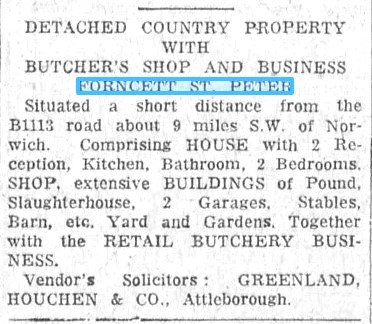Butchers
Butchers
In the 19th and early 20th centuries the butcher was an important member of the rural community. For many agricultural labourers meat in the diet would have been limited to their own chickens or wild rabbits. Many farming families would have kept one or more pigs which were fed on scraps and then slaughtered to provide pork, bacon and sausages. In a recording made by Edward Thurston, who lived at Corner Farm in Forncett End, he describes the slaughtering of a pig on the farm in the 1920s.
A search of the Trade Directories and the census records identifies a number of men in Forncett who gave their occupation as "butcher". However, in some cases these appear to have been farmers who also had a slaughterhouse and they didn't necessarily run a butchers shop. There was only one building that clearly served as such a shop and it did so for a total period of 150 years.
Butchers Cottage still stands at the top of Tabernacle Lane in Forncett End and it first appears on the 1839 tithe map of Forncett when it was owned by John Lain. John Lain married Sarah Turner in Wymondham in 1818 and soon after they moved to Forncett where John built both a cottage and a slaughterhouse to carry out his business. Their first child, Sarah, was baptised in Forncett in 1821.

John Lain's cottage appears on the 1839 tithe map (Plot 116)
By 1851 John Lain had retired and moved elsewhere in the village. His eldest son, also John, was running the butchers and farming 40 acres where he probably raised his own stock. Sadly, John Lain jnr. died in 1852 and so the business was taken over by his brother, James, who then ran the butchery until at least 1881. By the 1891 census, the business had been taken over by Henry Southgate who was living there with his wife, four daughters and a butcher's assistant. However, Southgate didn't stay long and in 1901 the occupants of Butcher's Cottage were Harry Charlish, his wife and young son. At this time James Lain was still living in Forncett and may have still owned the cottage and land.
Butchers Cottage changed hands again in 1904 and the new butcher was Bertie Edmund Smith from Bunwell. In October 1903 Bertie had married Mary Elizabeth Blyth (known as Bessie) and it would appear that Bertie's father, Robert Isaac Smith, who was a farmer in Bunwell, had purchased the property and set Bertie up in business. Less than two years earlier, in 1902, Bertie's younger sister, Laura, had married George Tann who ran Forncett End Stores directly opposite the butchers.
Bertie seems to have rapidly made a name for himself. At the first Wymondham Agricultural Society Show, on 10th September 1906, he won first prize in the category for 'Tradesmen's turn-out for hackneys, cobs, or ponies and light vehicles'. His success was recorded in a photo taken just outside Butcher's Cottage with Bertie's two assistants (probably Frederick Pinchen (left) and Charles Rush (right) and Bertie in the striped apron.

Bertie and Bessie had two sons, Bertie Edmund Allen (born in Nov 1904) and Kenneth Edmund (born in 1906). Both sons appear in a photo believed to have been taken in December 1910 when Bertie exhibited a fat bullock and offered a prize for the person who could most accurately guess its weight! (See photo in header).
From 1914 until 1919 Bertie was the tenant of Gilder's Wood Farm but for most of this period he was in the army. He joined the Royal Engineers in May 1915 and spent some time in Palestine. He was finally demobbed in July 1919. Back in Forncett End he continued his business and he rented various pieces of land, presumably to graze stock, one of which was close to Sandpit Farm on Overwood Lane. This is probably where Bertie met Florence Knivett, whose father was working as a horseman at Sandpit Farm. In 1929 Bertie (age 50) started an affair with Florence (age 18) which led to both of them leaving Forncett and moving to Norwich where Bertie took a job managing a butcher's shop. The couple lived as man and wife and had four children between 1930 and 1938. They stayed together until Bertie's death in 1960.
Bessie Smith and her sons moved to live at 4, Mill Road, Forncett and the business in Tabernacle Lane was taken over by Percy Berwick who had previously been a butcher in Melton Constable.

Percy's order book showed a wide-ranging list of customers, in Aslacton, Ashwellthorpe, Bunwell, Carleton Rode, Forncett, Fundenhall, Hapton, Tacolneston and Wreningham. The 1939 register records Percy, his wife May and their son Donald living at Butcher's Cottage but owing to ill health the Berwicks had to give up the business after WW2.

Bertie Smith's son, Kenneth, had followed in his father's footsteps and had married and moved to work as a butcher in Blofield. So, in around 1947 he came back to Forncett End to run what had been his father's business. His assistant was young Keith Daniels after being trained at City College and working at R S Baker's in Norwich (see photo below).

Kenneth Smith finally retired and the business was put up for sale. It was advertised in the EDP on 12 July 1972.

When Percy Berwick's health improved he built a small butcher's shop at 'Chancellors' in Forncett End. That building still stands today.

Butcher's Cottage was redeveloped and became a private residence. However, the outbuildings (probably the originals built by John Lain in the 1820s) still stand today in what looks to be their original form.

The initial material for this page came from Forncett Archive Note No.11, published by John Webster in 2010. With additional thanks to John Herne and Su Leavesley for contributions to this webpage.

